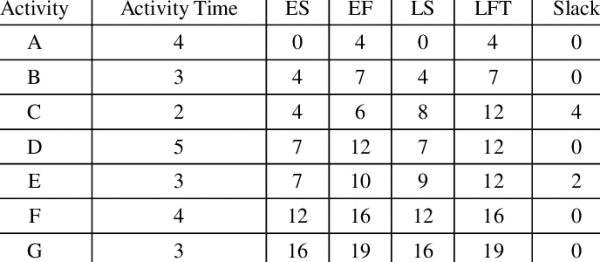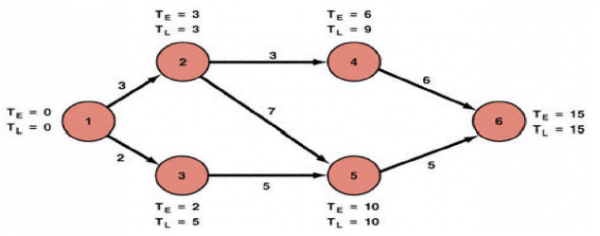Slack time is a relevant concept in project management as it relates to proper task completion. This article will provide an overview of slack time. It will then continue by providing a description of how we can calculate slack time. Different examples of slack time calculation and models to calculate slack time will also be included. The article will end with a comparison of slack time and total slack.
When managing a project it is your duty as a project manager to consider the time of task completion. In the context of project management, slack time is defined as “the amount of time you can delay the task without interfering with another task or affecting the completion date of your project.”
The phenomenon of slack time happens as a result of productivity imbalances among workers and it is the responsibility of the project manager to ensure that project deadlines are met.
There are two factors that must be taken into consideration in order to make the best use of slack time. First, you as the project manager must have a clear focus on your project goals to ensure that the deadlines will be met. Second, you must understand the importance of teamwork and allow your team to make suggestions on how to make the best use of the time. Furthermore, this form of delegation will leave you more free time and will provide your workers with more autonomy.

Importance of slack time
Slack time is an important aspect of a project and therefore you as an aspiring manager ought to have a clear understanding of its relevance. First, slack time indicates the amount of flexibility you as a project manager has in your project. This allows the development of a more realistic timeline for the activities. Furthermore, projects which involve slack time tend to be of a higher quality and stay within the limited budget.
Slack also helps you as a project manager to have a clear understanding of the importance of particular tasks in a project. In addition to staff and equipment expenses delays have a negative domino effect on other activities in the project. In fact, such missteps might have a critical impact on the entire success of the project. From the viewpoint of the project manager, slack is an important prioritization tool that allows them to consider the best ways of allocating specific tasks to ensure greater productivity.
How to calculate slack?
The calculation of slack is rather straightforward and it contains only a few simple steps.
Slack Time Formula
The following formula is used to calculate slack time:
ST = LST – EST
ST is the slack time 2) LST is the latest possible start time 3) EST is the earliest possible start time
From a mathematical standpoint, slack time is equal to the latest possible start time minus the earliest possible start time, and any time after the latest start time would result in project failure.

Examples of slack time calculation
As a project manager, you can easily use the abovementioned formula in order to perform a slack time calculation. Two different examples of slack time calculation will be provided in order to better clarify the process.
Example 1:
The following example outlines how to calculate slack time.
First, determine the earliest possible start date. For this example, the earliest date is October 10th.
Next, determine the latest possible start time. In this case, the latest start date is October 15th.
Finally, calculate the slack time by subtracting the earliest from the latest.
ST = LST – EST
ST = 15 – 10
ST = 5 day slack time
Example 2:
Let’s say that you have to complete a task in a project by the 3rd of November. You realize that the earliest start time is the 15th of October and the latest start time is the 27th of October. In this case, your calculation should be as follows:
Slack Time= LST (27th of October)- EST (15th of October)
In this case, the slack time is 12 which means that you have 12 days to complete the task.

Figure 1: An example of Slack Time Calculation
Slack Time in GANTT chart and PERT Network
In the following part of the article, there will be two examples of slack time calculation in two different contexts which involve the GANTT chart and the PERT Network.
Example 1: PERT NETWORK
The calculation for slack time is conducted for every event in the following network as shown in the figure by recognizing the latest starting date and the earliest expected date. TL – TE = 0 for event 1.

Slack Time Calculation in PERT Network
Example 2: GANTT chart
In the image presented here, the light-green color shows the free slack available. As can be seen, there is a lot of room to extend the tasks without affecting the Critical Path.

Slack Time in the GANTT chart
Free Slack vs Total Slack
The free slack of an activity can be defined as “the time this activity can be delayed without impact on the following activity.” On the other hand, total slack is defined as “the amount of time a task can be delayed without impacting the delivery of the project.” So, while free slack is concerned with the forthcoming activity in a project, the impact of total slack tends to affect the entire project.
Free Slack formula:
Free Slack = ES (Of Successor) – EF (Of Current)
Total Slack formula:
Total Slack = LS – ES or LF – EF
Here ‘LS’ indicates a late start date, while ‘ES’ indicates an early start date. Similarly, ‘LF’ indicates a late finish date, while ‘EF’ indicates an early finish date.
It must be emphasized that free slack is differently known as “free float” while total slack is known as “total float”
This article provided a rather general presentation of the slack time concept. Slack time remains an important concept for project managers which if utilized properly will lead to many benefits for the managers and their teams. This is because an understanding of the slack time concept, its importance, and the context in which it can be used will lead to better task prioritization and ultimately to a more effective approach toward the completion of a project.
How do you calculate slack time in project management?
The formula for calculating slack time (ST) is straightforward. Determine the latest start time (LST) and the earliest start time (EST). Subtract EST from LST to get the total slack time of the project.
Why is slack important in project management?
Slack is important as it allows the project manager to better estimate the duration of projects and also to prioritize their tasks better.
What is positive slack?
A positive slack shows the amount of time that the task can be delayed without delaying the project’s finish date.
